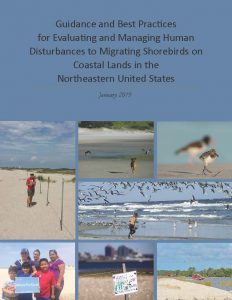Guidance and Best Practices for Evaluating and Managing Human Disturbances to Migrating Shorebirds on Coastal Lands in the Northeastern United States
RECOMMENDED CITATION
Mengak, L., A.A. Dayer, R. Longenecker, and C.S. Spiegel. 2019. Guidance and Best Practices for Evaluating and Managing Human Disturbances to Migrating Shorebirds on Coastal Lands in the Northeastern United States. U.S. Fish and Wildlife Service.
 Managers recognize human disturbance as a serious threat facing shorebirds throughout their annual cycle. Yet, most of the current research and management of human disturbance on shorebirds focuses on the breeding season. To address this gap, Virginia Tech and US Fish and Wildlife Service developed “Guidance and Best Practices for Addressing Human Disturbance to Shorebirds at Fall Migratory Stopover Sites” for the Northeastern U.S. Utilizing a transdisciplinary approach, integrating social, ecological, and stakeholder knowledge to create the document allowed for a more comprehensive set of guidelines, with the goal of wider utility for managers.
Managers recognize human disturbance as a serious threat facing shorebirds throughout their annual cycle. Yet, most of the current research and management of human disturbance on shorebirds focuses on the breeding season. To address this gap, Virginia Tech and US Fish and Wildlife Service developed “Guidance and Best Practices for Addressing Human Disturbance to Shorebirds at Fall Migratory Stopover Sites” for the Northeastern U.S. Utilizing a transdisciplinary approach, integrating social, ecological, and stakeholder knowledge to create the document allowed for a more comprehensive set of guidelines, with the goal of wider utility for managers.
The document includes:
- a consensus definition of human disturbance to shorebirds, developed through manager and scientist input;
- a review of the state of the ecological and social knowledge for 14 priority disturbance types that affect migratory shorebirds;
- a literature synthesis of metrics used to evaluate disturbance & disturbance thresholds;
- 9 best practices to reduce disturbance; and
- field methods for evaluating shorebird disturbance at the site level.
All of these components were integrated into a guidance and best practices document that is now available to coastal land managers, aiming to contribute to Atlantic Flyway-scale (e.g., Atlantic Flyway Shorebird Initiative) and regional (e.g., Northeast National Wildlife Refuge System) conservation goals. Additionally, a comprehensive references list in now available for ecological and social science literature related to human disturbance.
- Full Document: Guidance and Best Practices for Addressing Human Disturbance to Shorebirds at Fall Migratory Stopover Sites (this is the full document where all jump links within the plan will function).
- Main Body of Document: This includes all sections except the Appendices (jump link to appendices will not work)
- Appendix Section of Document: Includes Appendix 1-5 (jump links to the main body of the document will not work)
- Literature Review: In alphabetical order
- Literature Review: Key Terms
- Journal article: Defining Human Disturbance in Environmental Management
- Webinar: Guidance and Best Practices for Addressing Human Disturbance to Shorebirds at Fall Migratory Stopover Sites
